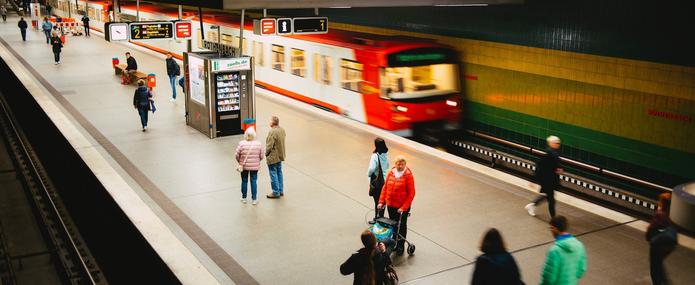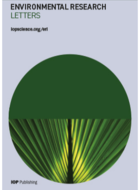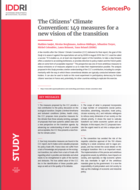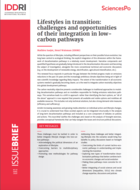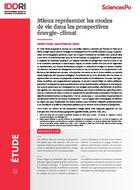A consideration of lifestyles and their sobriety has long been at the heart of thinking on sustainability, yet its explicit integration into national and international decarbonisation pathways is relatively recent. What methodological and substantive challenges does this evolution present with respect to the understanding, representation and projections of the ecological transition?
The evolution underway. Both storylines and quantified assumptions surrounding lifestyles and behavioural change have progressively become part of the discussion around decarbonisation, thus complementing technical and economic transformations on the supply side, the more traditional field of study for climate change solutions. For example, the Net Zero study conducted by the European Climate Foundation1 at the European level includes significant changes on the demand side and places these at the same level as efforts regarding technical efficiency. The contribution of this “demand lever” has been clearly identified in the report, with explicit assumptions regarding dietary practices and mobility preferences adopted in the scenario. At an international level, the Special Report on Global Warming of 1.5°C by the IPCC2 puts forth a group of scenarios which strongly incorporate lifestyle and behavioural changes compatible with the goals set by the Paris Agreement on climate change.
What has led to this evolution? We can look at this evolution as a reaction to several pressures: the clock is ticking, and the limited progress made in reducing greenhouse gas emissions over the last thirty years has strengthened our need to act rapidly in the coming decades. In addition, progress in the scientific understanding of the impacts of climate change has led to an awareness of the need to strengthen the ambition of our climate goals over time. Gradually, the scale and magnitude of the necessary transformation has become clearer, with carbon neutrality as the overarching goal. At the same time, the carbon budget available has been progressively reduced, putting too much pressure on the traditional levers of decarbonisation and on modellers tasked with identifying compatible emissions reduction pathways.
Where does the paradox lie? On the one hand, modellers and scenario-makers—who are most often economists or engineers—can regard changes in the demand for goods and services (such as meat consumption, heating preferences, passenger and freight kilometres, etc.) as silver bullets to achieving reduction targets. These changes are not directly associated with implementation costs when they are represented in these models, and they can also seem more flexible (one could assume, for example, their rapid implementation, as opposed to the deployment of large-scale infrastructure).
On the other hand, while researchers in the social sciences and humanities can be gratified by this growing interest in a dimension which they consider central to the ecological transition, they do tend to take a contrary view. Their research shows that better integrating the “human” factor of the transition generally reveals a number of obstacles with regard to lifestyles and behaviour, which may stand in the way of decarbonisation policies; one can take the changes in practice required to move towards sustainable mobility or sustainable housing as an example of this.3 From this point of view, traditional decarbonisation scenarios can be seen as too optimistic, as they do not take into account challenges that have not been identified or included in the models (such as the reluctance to buy electric vehicles, change heating preferences, etc.) and which could, in fact, add to the technical and economic challenges, and help shape them.
How can we overcome this paradox? The study conducted by IDDRI shows that this paradox is a mere indication of our incomplete understanding of what this transition—in all its dimensions— would entail in real terms. A better reflection of the social and societal dimensions of the transition in scenario exercises should neither inject further optimism nor pessimism as to our real capacity to reduce emissions. Rather, it should contribute to modifying the simplified projections of current emissions reduction pathways. As such, integrating a lifestyle dimension in the scenarios would neither constitute a magic wand nor an impediment, but would simply add an additional layer of understanding to the complex changes necessary for the transition. This should, in fact, not amount to simply adding another building block to existing scenarios, but rather help us imagine completely new scenarios for the transition and new possibilities, like the TYFA modelling exercise for an agroecological Europe in the future, which incorporates both a change in diets and in agricultural production.
Our study shows that a consideration of this new dimension is crucial to scenarios and policy discussions associated with them. Further, it identifies challenges and areas of future work to move towards scenarios that better integrate the knowledge of social and behavioural sciences in a field that has been traditionally governed largely by economic and technical sciences. Thus, finding solutions for the dialogue between different disciplines and modelling methodologies will be crucial to moving further in this direction. In this context, the recent nomination of a sociologist to the Haut Conseil pour le Climat (independent High-Level Advisory Council on Climate Change)4 of the French government is certainly a promising sign. This should help strengthen these joint efforts and overcome this paradox. The work has only just begun.
- 1ECF (2018). Net zero by 2050: from whether to how.
- 2https://www.ipcc.ch/sr15/
- 3Many studies in the social sciences and humanities have been conducted on the limits of eco-district experiments: IDDRI contributed with the Movida project, carried out in association with the Centre de recherche pour l'étude et l'observation des conditions de vie (Crédoc), cf. Saujot, M. (2015). The energy transition and the challenge of incorporating uses and participation: eco-district experiments, IDDRI, Working Paper.
- 4https://www.hautconseilclimat.fr/actualites/nomination-de-deux-nouvelles-expertes-au-haut-conseil-pour-le-climat/

